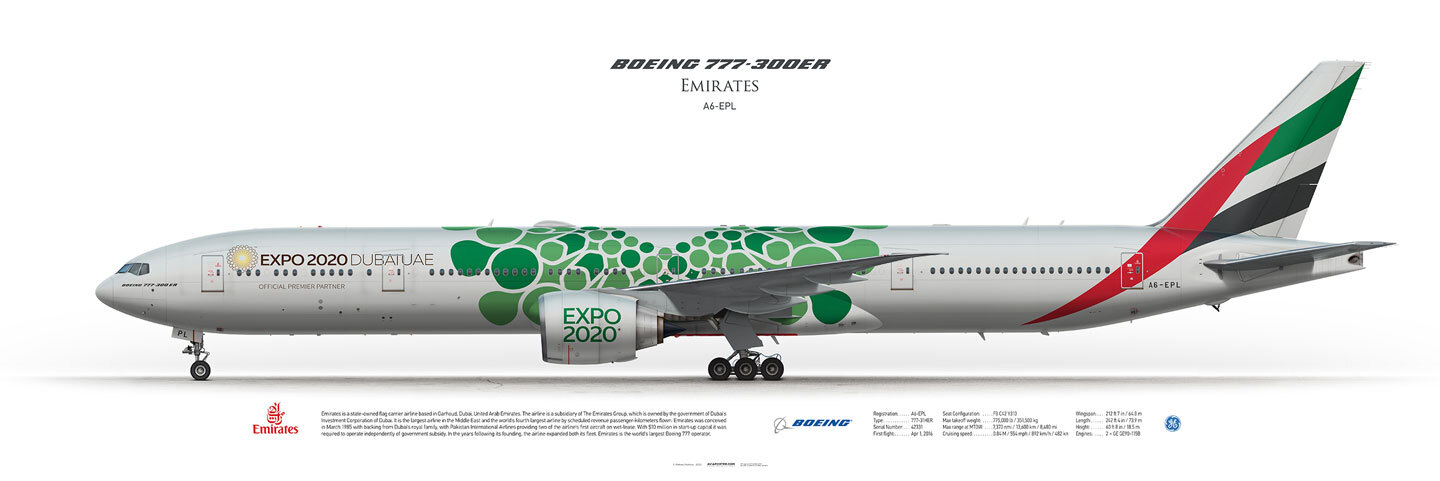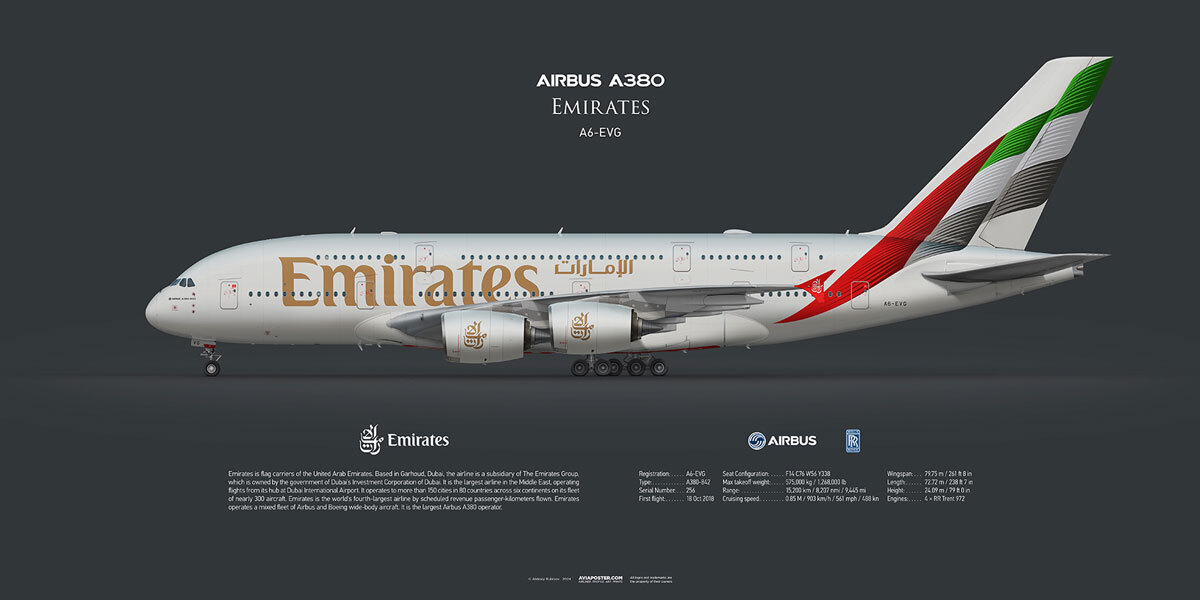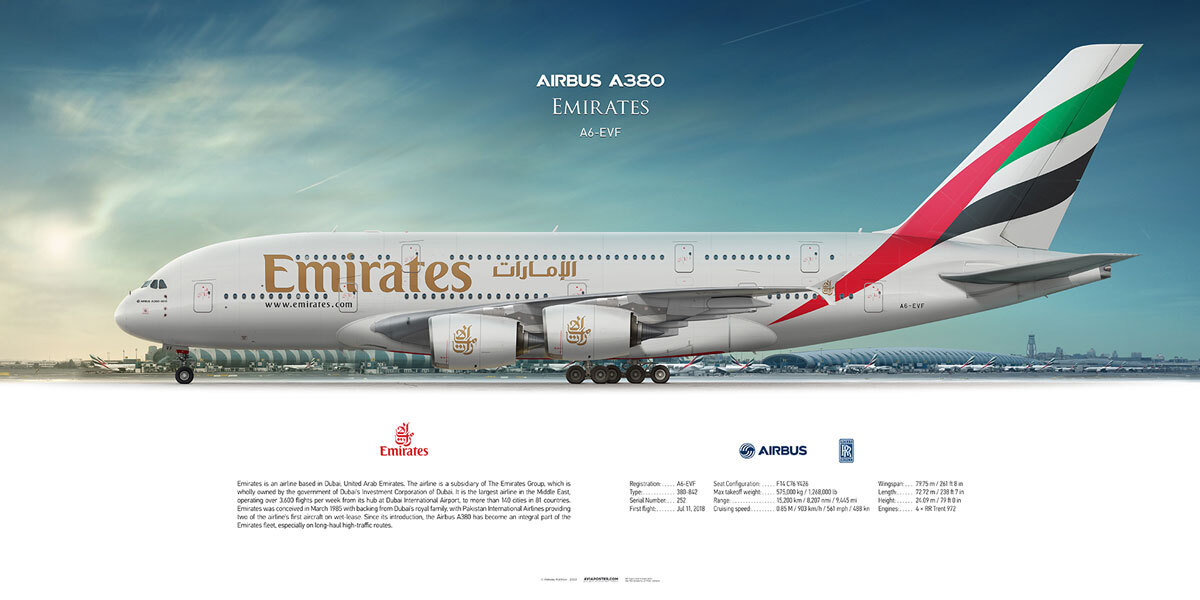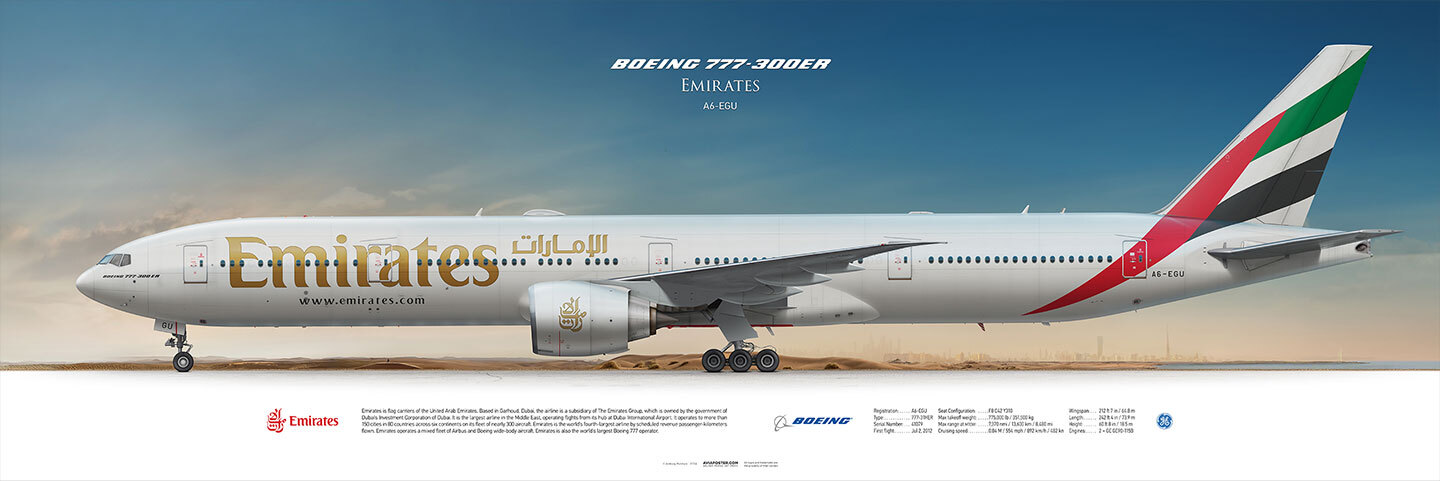When it comes to luxury, innovation, and global connectivity in aviation, few names shine as brightly as Emirates. Founded in 1985 in Dubai – the most forward-thinking of the United Arab Emirates – Emirates has transformed from a modest startup into the Middle East’s largest airline and a globally celebrated brand that embodies excellence. Even today, Emirates continues to redefine air travel standards by merging cutting-edge technology with unmatched service.
The Birth of a Giant
The story of Emirates (airline) began in 1985, when Dubai resolved to establish its own airline. It was a time of significant shifts. The region’s leading carrier at the time, Gulf Air, had begun scaling back its flights to Dubai. Spotting this gap, the emirate’s ruling dynasty, led by Sheikh Mohammed bin Rashid Al Maktoum, decided the moment was ripe for action.
The initial step was humble: Emirates leased two aircraft from Pakistan International Airlines (PIA) – a Boeing 737-300 and an Airbus A300B4-200. PIA also provided training for staff and technical assistance. On October 25, 1985, Emirates launched its first flight from Dubai to Karachi, followed soon after by a route to Bombay (now Mumbai).
With a mere $10 million budget and a firm directive to operate without government subsidies, Emirates had to swiftly learn to thrive in a cutthroat industry. Under the guidance of Sheikh Ahmed bin Saeed Al Maktoum, the airline expanded rapidly. By 1986, new destinations like Colombo, Dhaka, Amman, and Cairo had joined its network.
Unrivaled in the Air
Emirates rightfully boasts one of the most modern and awe-inspiring fleets in the industry, composed entirely of wide-body aircraft. As of early 2025, the airline operates around 260 planes, predominantly Airbus A380s and Boeing 777s, with new Airbus A350-900s joining the fleet since 2024. This wide-body approach allows Emirates to serve high-demand long-haul routes with peak efficiency and passenger comfort.
Emirates is the world’s largest operator of the Airbus A380, with 116 of these aircraft in its fleet. This double-decker “Superjumbo,” often dubbed the flagship of global aviation, is an engineering marvel, offering spacious cabins, onboard lounges, and even spa showers for First Class travelers. The A380 giants are the cornerstone of Emirates’ long-haul operations, especially on routes to major global hubs like London Heathrow, New York’s JFK, and Sydney, Australia.
The Birth of a Giant
The story of Emirates (airline) began in 1985, when Dubai resolved to establish its own airline. It was a time of significant shifts. The region’s leading carrier at the time, Gulf Air, had begun scaling back its flights to Dubai. Spotting this gap, the emirate’s ruling dynasty, led by Sheikh Mohammed bin Rashid Al Maktoum, decided the moment was ripe for action.
The initial step was humble: Emirates leased two aircraft from Pakistan International Airlines (PIA) – a Boeing 737-300 and an Airbus A300B4-200. PIA also provided training for staff and technical assistance. On October 25, 1985, Emirates launched its first flight from Dubai to Karachi, followed soon after by a route to Bombay (now Mumbai).
With a mere $10 million budget and a firm directive to operate without government subsidies, Emirates had to swiftly learn to thrive in a cutthroat industry. Under the guidance of Sheikh Ahmed bin Saeed Al Maktoum, the airline expanded rapidly. By 1986, new destinations like Colombo, Dhaka, Amman, and Cairo had joined its network.
Unrivaled in the Air
Emirates rightfully boasts one of the most modern and awe-inspiring fleets in the industry, composed entirely of wide-body aircraft. As of early 2025, the airline operates around 260 planes, predominantly Airbus A380s and Boeing 777s, with new Airbus A350-900s joining the fleet since 2024. This wide-body approach allows Emirates to serve high-demand long-haul routes with peak efficiency and passenger comfort.
Emirates is the world’s largest operator of the Airbus A380, with 116 of these aircraft in its fleet. This double-decker “Superjumbo,” often dubbed the flagship of global aviation, is an engineering marvel, offering spacious cabins, onboard lounges, and even spa showers for First Class travelers. The A380 giants are the cornerstone of Emirates’ long-haul operations, especially on routes to major global hubs like London Heathrow, New York’s JFK, and Sydney, Australia.

The Boeing 777 family, including the 777-200LR and 777-300ER, forms the backbone of Emirates’ fleet. Known for its reliability and long-range capabilities, the “Triple Seven” serves a diverse array of routes. In 2025, as part of a modernization initiative to elevate passenger service, Emirates unveiled updated Boeing 777s with refreshed interiors. Complementing this, ten Boeing 777F freighters underpin the Emirates SkyCargo division.
Looking forward, Emirates plans to grow its fleet with new models. Sixty-five Airbus A350-900s are in the pipeline, with three already integrated into the fleet and operational. This year, the airline anticipates the arrival of its first Boeing 787-10s, followed by Boeing 787-8s. Peering further ahead, the yet-to-be-certified Boeing 777-8 and 777-9 models are on the horizon.
Unlike many airlines, Emirates entirely bypasses narrow-body aircraft, a choice that reflects its strategy of linking major world cities through its Dubai hub. This approach has sparked criticism from competitors, who allege Emirates exploits unfair advantages like Dubai’s strategic location and open-skies policies. Emirates counters these claims, arguing its success is driven by operational efficiency and a customer-first mindset, not subsidies.
Heavenly Luxury
Emirates’ reputation rests on delivering an exceptional in-flight experience. Whether you’re in Economy, Business, or First Class, the airline’s meticulous attention to detail stands out-often serving as a benchmark for competitors.
Looking forward, Emirates plans to grow its fleet with new models. Sixty-five Airbus A350-900s are in the pipeline, with three already integrated into the fleet and operational. This year, the airline anticipates the arrival of its first Boeing 787-10s, followed by Boeing 787-8s. Peering further ahead, the yet-to-be-certified Boeing 777-8 and 777-9 models are on the horizon.
Unlike many airlines, Emirates entirely bypasses narrow-body aircraft, a choice that reflects its strategy of linking major world cities through its Dubai hub. This approach has sparked criticism from competitors, who allege Emirates exploits unfair advantages like Dubai’s strategic location and open-skies policies. Emirates counters these claims, arguing its success is driven by operational efficiency and a customer-first mindset, not subsidies.
Heavenly Luxury
Emirates’ reputation rests on delivering an exceptional in-flight experience. Whether you’re in Economy, Business, or First Class, the airline’s meticulous attention to detail stands out-often serving as a benchmark for competitors.

The Emirates ICE system – short for “Information, Communication, Entertainment” – is a standout feature. Debuted in 2003 and upgraded to “ICE Digital Widescreen” in 2007, it offers over 4,000 channels of movies, TV shows, music, and podcasts across all aircraft. Economy Class passengers enjoy some of the largest screens in the industry, while Business and First Class cabins feature high-definition personal displays. ICE also includes live TV, external cameras for takeoff and landing views, and high-speed Wi-Fi on most flights.
Emirates takes in-flight dining to new heights with regionally inspired menus crafted by “five-star” chefs. First and Business Class passengers can indulge in multi-course meals served on Royal Doulton china, paired with exquisite wines. Economy Class offers hearty, flavorful dishes tailored to the route – such as Middle Eastern mezze on flights to Dubai or Indian curry on trips to Mumbai. The “Dine on Demand” service in First Class lets passengers eat at their convenience.
First Class on the A380 is the pinnacle of luxury, featuring private suites, showers, and a lounge bar. Business Class on the A380 offers lie-flat seats and access to a relaxation area, while Economy Class provides spacious seating and ergonomic design. Recent upgrades to the Boeing 777 fleet include modernized interiors with contemporary color palettes and enhanced comfort.
Emirates’ cabin crew, drawn from over 130 nations, is renowned for its professionalism and friendliness. This multicultural team reflects the airline’s global scope, ensuring passengers feel at home regardless of their origins.
Crossroads of Seven Paths
From Terminal 3 at Dubai International Airport (DXB), Emirates flies to over 150 destinations across 80 countries on six continents. From New York to Tokyo, Cape Town to Sydney, Emirates links the world through Dubai, leveraging the city’s role as a junction between East and West.
The airline’s vigorous growth hasn’t come without pushback. Competitors like Air France-KLM have accused Emirates of benefiting from state backing – a charge Emirates President Sir Tim Clark has firmly denied, pointing to the airline’s financial transparency and profitability. Despite such critics, Emirates flourishes, expanding its routes and forging codeshare partnerships with airlines like Japan Airlines, Qantas, and Korean Air.
Emirates takes in-flight dining to new heights with regionally inspired menus crafted by “five-star” chefs. First and Business Class passengers can indulge in multi-course meals served on Royal Doulton china, paired with exquisite wines. Economy Class offers hearty, flavorful dishes tailored to the route – such as Middle Eastern mezze on flights to Dubai or Indian curry on trips to Mumbai. The “Dine on Demand” service in First Class lets passengers eat at their convenience.
First Class on the A380 is the pinnacle of luxury, featuring private suites, showers, and a lounge bar. Business Class on the A380 offers lie-flat seats and access to a relaxation area, while Economy Class provides spacious seating and ergonomic design. Recent upgrades to the Boeing 777 fleet include modernized interiors with contemporary color palettes and enhanced comfort.
Emirates’ cabin crew, drawn from over 130 nations, is renowned for its professionalism and friendliness. This multicultural team reflects the airline’s global scope, ensuring passengers feel at home regardless of their origins.
Crossroads of Seven Paths
From Terminal 3 at Dubai International Airport (DXB), Emirates flies to over 150 destinations across 80 countries on six continents. From New York to Tokyo, Cape Town to Sydney, Emirates links the world through Dubai, leveraging the city’s role as a junction between East and West.
The airline’s vigorous growth hasn’t come without pushback. Competitors like Air France-KLM have accused Emirates of benefiting from state backing – a charge Emirates President Sir Tim Clark has firmly denied, pointing to the airline’s financial transparency and profitability. Despite such critics, Emirates flourishes, expanding its routes and forging codeshare partnerships with airlines like Japan Airlines, Qantas, and Korean Air.

Overcoming Obstacles
Emirates’ swift ascent hasn’t always been smooth. The 2008 financial crisis tested its endurance, yet it emerged stronger, opening its dedicated Terminal 3 at Dubai International Airport on October 14 that year – a grand facility now home to all its operations.
The COVID-19 pandemic halted much of its fleet, but Emirates recovered by expanding strategic routes and adopting stringent health measures. Competitors’ claims of unfair advantages persist, yet Emirates keeps adding to its accolades –over 400 awards for outstanding service – and boasts a broad base of loyal customers.
Shall We Fly?
Emirates airline is more than just an airline – it’s a symbol of ambition and luxury. From its modest origins to its current standing as an industry titan, Emirates continues to reshape air travel with its fleet, service, and vision for the future.
Whether you’re a seasoned traveler or planning your first trip, flying with Emirates is an experience that won’t leave you indifferent. So, the next time you dream of far-off lands, book a flight with Emirates – where the journey is as remarkable as the destination.
Emirates’ swift ascent hasn’t always been smooth. The 2008 financial crisis tested its endurance, yet it emerged stronger, opening its dedicated Terminal 3 at Dubai International Airport on October 14 that year – a grand facility now home to all its operations.
The COVID-19 pandemic halted much of its fleet, but Emirates recovered by expanding strategic routes and adopting stringent health measures. Competitors’ claims of unfair advantages persist, yet Emirates keeps adding to its accolades –over 400 awards for outstanding service – and boasts a broad base of loyal customers.
Shall We Fly?
Emirates airline is more than just an airline – it’s a symbol of ambition and luxury. From its modest origins to its current standing as an industry titan, Emirates continues to reshape air travel with its fleet, service, and vision for the future.
Whether you’re a seasoned traveler or planning your first trip, flying with Emirates is an experience that won’t leave you indifferent. So, the next time you dream of far-off lands, book a flight with Emirates – where the journey is as remarkable as the destination.
